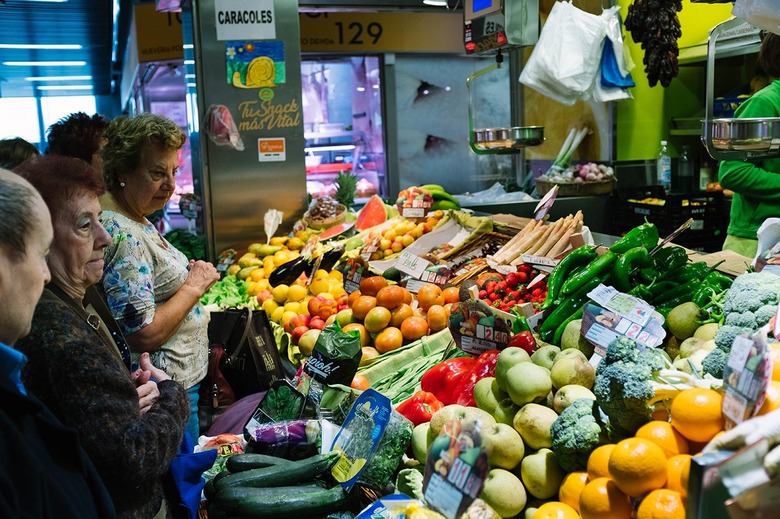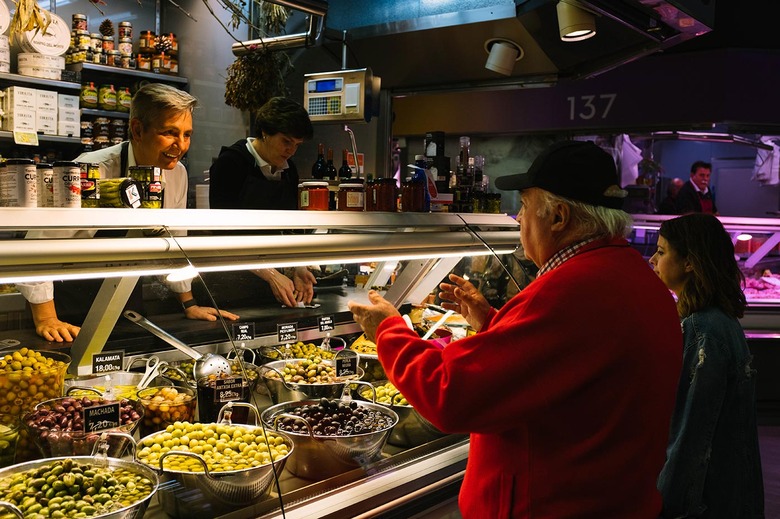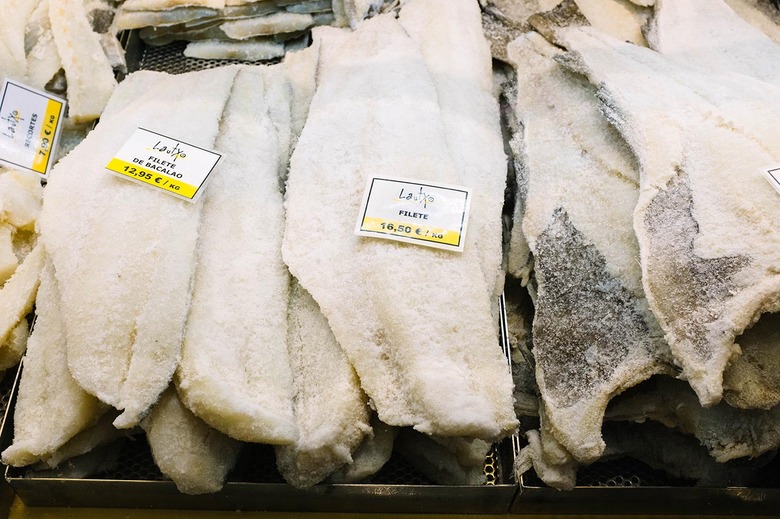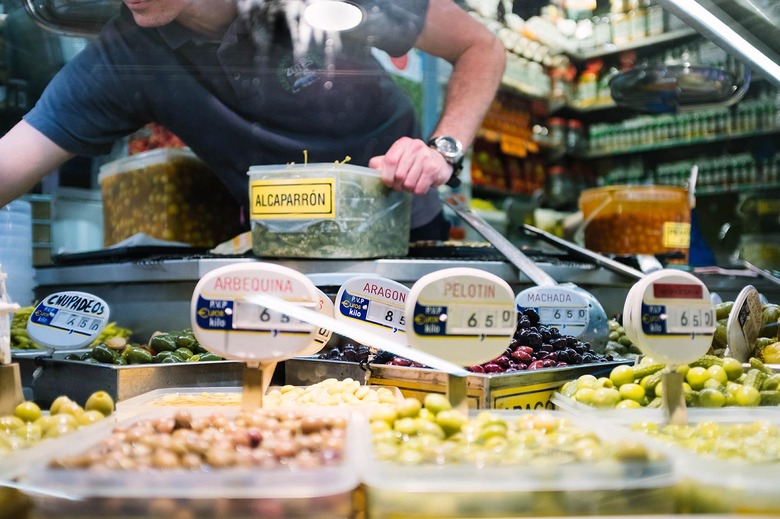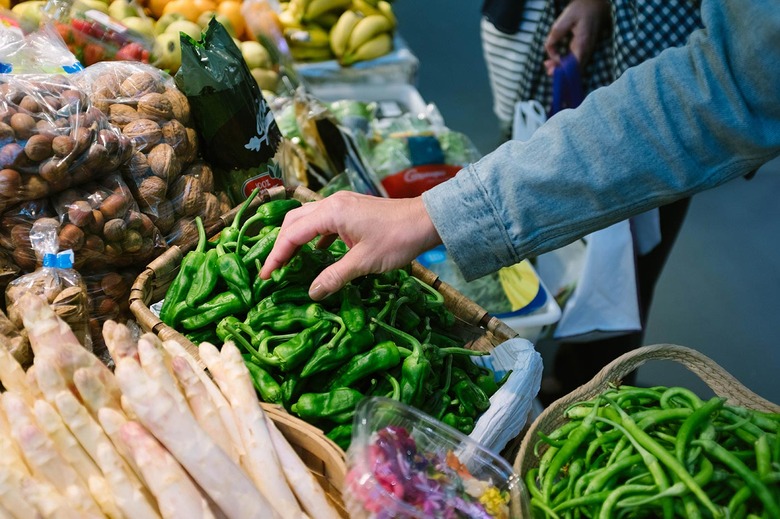Farmers' Market Travel Tips
The modern farmer gives us her tips for getting the most out of food markets while traveling
On a recent rainy morning in Bilbao, Spain, Katina Connaughton was on the hunt for fresh produce at Ribera Market, the permanent indoor marketplace located in the historical center of the city. When asked whether she knew any Spanish—or Basque, perhaps?—she laughed. "You have to come to a market with realistic expectations and an open mind," she said, unfazed. "There's a common language of pointing and enthusiasm."
Katina is a sprightly horticulturalist with a reassuring cadence and arms ripe with tattoos. She's also the farmer behind SingleThread, the highly esteemed farm-inn-restaurant where her husband, Kyle, a pedigreed chef with a résumé to prove it, runs the kitchen.

The day before, the pair had sat in a packed conference room deep in the corridors of the Guggenheim Museum Bilbao to field questions from a crowd of international reporters. They had traveled to Spain for the World's 50 Best Restaurant Awards to accept the Miele One to Watch Award, a prestigious honor bestowed to a restaurant "outside the main 50 Best list" but "with strong potential to rise up the ranking in the near future." (SingleThread came in at 91 this year.)
A 52-seat restaurant with five guest rooms and its own farm, SingleThread has become one of the most notable fine dining restaurants in the country since opening in December of 2016.
The tasting menu, a produce-driven, 11-course Japanese kaiseki-style experience, is informed entirely, as chef Kyle explained to the press, "by what Katina and her team are growing." He added, "All of our creative R&D and long-term planning happens on the farm," which occupies five acres on a 180-acre vineyard parcel on the banks of the Russian River. If chefs are typically the visible driving force behind a restaurant's success, SingleThread takes the opposite approach: Everything begins with the farmer.
RELATED How Miele Is Pushing Innovation Forward, In and Out of the Kitchen "
SingleThread Farm is located just 10 minutes from the restaurant and specializes in rare produce varietals that are impossible to source elsewhere in Sonoma County and California. Katina found her calling in 2003 when the family moved to a rural fishing village in Hokkaido, Japan, for a job Kyle accepted with acclaimed French master chef Michel Bras.
"It was a big turning point for me," she recalled, as heavily made-up grandmothers also browsing the market milled about close by. "We were right on the coast. There were mountains. There was a lot foraging. It was all around me and all very inspiring."
Get there early (or late).
There's something to be said about going as early as possible to get the first pick of everything. Naturally, that's the way Katina Connaughton approaches farmers' markets at home. On the other hand, she says, if you have access to a kitchen during your trip and you're looking for good deals, there's nothing stopping you from going at the very end of the market's hours.
Don't buy too soon.
Katina advises to walk around the whole market once and return to whatever piqued your interest along the way, so you don't feel buyer's remorse if you come across a better version of something further down the line. Make mental notes and begin to build a shopping list in your mind.
Let your eyes guide you.
Research is important for knowing where to go and what to expect, but Katina warns that may set up unrealistic expectations. Plus, there's nothing better than discovering something you've never seen before. The best way to challenge yourself is to simply gravitate toward whatever catches your eye.
Be careful of food souvenirs.
If you're looking to take any edible souvenirs home, make sure you understand what's prohibited by U.S. Customs. Spices and preserved products might be your best bet. But also be weary: The general rule of thumb with exports is the best stuff stays home. If you can go directly to the source, savor and enjoy it.
In the end, it all comes down to taste.
Though you can "taste with your eyes to a certain degree," you ultimately have to check if the flavor is there. "Just because something is available doesn't mean it's at its best," Katina says. Be selective and taste something whenever you can. Also, look out for vendors with specialties they prepare themselves—it may turn out to be the best thing you eat during your stay.
The revelation Katina had in Hokkaido explains why she follows the Japanese almanac, which deconstructs the calendar year into 72 microseasons that are each roughly five days long. "We break the farm down into smaller quadrants, and then further sub-quadrants, and we work everything by hand," Katina explained. "We're able to take notice of each crop along the way throughout its lifetime, which allows us to be selective. For us, the five-day microseason is just a way to keep time and bring in the best of what's available at the peak of its life."
Strolling through the market, it became increasingly clear that the Connaughtons were not in Sonoma County anymore. With more stalls shuttered than open, the majority of them specialized in cured meats and fish. "Fish here is as important—if not more important—than the vegetables," she observed. But both wife and husband agreed that going to a market while traveling is about more than just finding produce—it's a reflection of the local culture. In being there, you'll absorb not just how and what locals eat, but also their traditions and values. Here in Basque Country, that just happens to be jamón, salted cod and, let's be real, more jamón.
A display of mushrooms caught Katina's eye, earning a sharp wail and a contemplative "This is exciting." SingleThread doesn't grow mushrooms, but it does work with a mushroom grower a few towns over. She explained how the team also forages in and around the property. "This is their connection to their food system," she said, scanning the varieties of fungi, "and that's so fascinating."
Katina moved on and plunged her hands into a basket of peppers. "With these, you're looking for deep vibrant colors. You want a firmness to them—once they start getting soft, that means they were picked quite a while ago," she directed. "I'm not sure if they're at their peak. But that's all part of being in a different place and learning about the produce."
She spent the rest her time at the market running her hands over baskets of white asparagus ("We had the most amazing ones last night"), tasting figs with a 20-day harvest window ("They're bursting—you've got to get a photo of that") and identifying rogue vegetables ("Oh, turnip greens!").
Though the quality of the produce at this particular market could never stand up to the hyper-seasonal bounty at SingleThread, you wouldn't know it based on this trip. After all, that's beside the point. Katina made that much clear as she headed back out into the rain, "This is their home; we just want to taste it."
Click through the slideshow to get Katina Connaughton's tips for visiting farmers' markets when you're traveling, then learn more about how Miele is constantly innovating.

